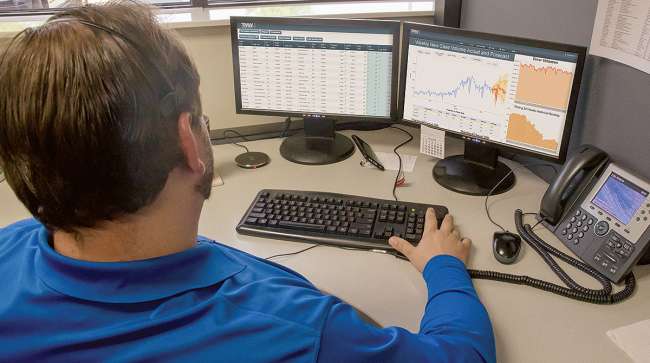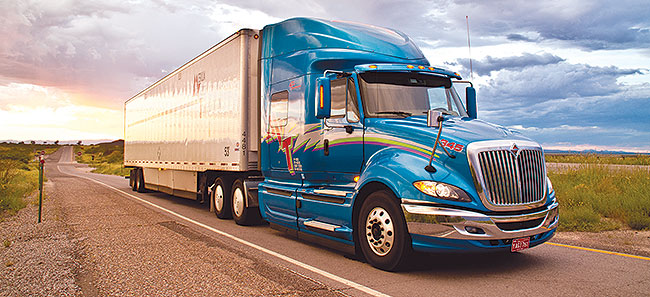The Integration Challenge

Mike Kelley is working to implement a new human resources information system at his company, Mesilla Valley Transportation. It’s a project that requires moving data from the IT systems of seven business units and integrating it within the new HR system. The goal is to create “a full census of every employee that works for us,” said Kelley, the company’s chief information officer.
Accomplishing that integration back in 2005 would have been a huge, daunting task, Kelley said.
Now? Much less so.
“In the last 10 years, our ability to do integration has increased greatly,” Kelley said.
The cloud computing services offered by businesses such as Amazon Web Services, Google and Microsoft Azure have made integration easier to accomplish, Kelley said.

Mesilla Valley Transportation's chief information officer credited cloud computing with reducing the challenge of integrating multiple IT systems. (Mesilla Valley Transportation)
Cloud computing refers to storing and accessing data and applications over the internet rather than keeping that information in on-premises computer systems. A carrier’s IT department can pay for a subscription to use the cloud-computing resources of providers such as Amazon, Google and Microsoft.
“We can achieve much more complex integrations,” Kelley said. “The tool set has grown. The cost to temporarily use those tools has decreased.”
There is a catch, though. The task of integrating systems “is never-ending,” Kelley and other technology executives said.
Neglect a completed integration and “you will find yourself in the back of the pack before you realize it,” Kelley said.
An integration should be revisited and perhaps redone, “so that you can leverage new methodologies, new technologies” that have emerged since the task was first done, he said.
Mesilla Valley Transportation, based in Las Cruces, N.M., ranks No. 72 on the Transport Topics Top 100 list of the largest for-hire carriers in North America.
Ray West, senior vice president and general manager of transportation management systems for TMW, a Trimble company that provides back-office software to Mesilla Valley Transportation, said, “Any time you integrate two systems it’s inherently complex. It takes a lot of work to create the integration in the first place and then there’s always maintenance that goes along with maintaining that integration.”
In trucking, the classic example of systems that need to be integrated are a carrier’s transportation management software and its in-cab mobile communications.
New vendors of those systems are entering the trucking IT market, and at the same time consolidation among various players is ongoing.
“Consolidation doesn’t necessarily eliminate or decrease the need for integration,” West said. “Just because two vendors consolidated — one acquired the other — that doesn’t lessen the complexity” of integrating their products.
Transportation management systems can be enterprisewide, supporting payroll, dispatch, customer relations, human resources, risk management, safety and regulatory compliance.
Vendors of those systems and vendors of mobile communications often partner to create integrations and maintain them.
TMW publishes application programming interfaces, or APIs, for its systems so that other vendors can access them and use them for integration. APIs enable the exchange of information between systems.
Mesilla Valley Transportation also uses trailer tracking technology from SkyBitz, which is integrated with TMW’s fleet management software and with Mesilla Valley’s “business intelligence infrastructure”— Microsoft SQL, SharePoint and Power BI, Kelley said.
Henry Popplewell, president of SkyBitz, said the vendor uses “very open APIs so we can readily incorporate a variety of technologies and the various data elements of disparate systems.”
An example is an integration with an automatic tire inflation system offered by Pressure Systems International, Popplewell said.
A goal beyond such integrations is to develop “smart trailer” technology, Popplewell said. “Not just where the trailer is located, but its condition. Is the trailer stopped or moving? Is it loaded or empty? Is the tire pressure all good?”
He said fleets “want to know if the asset is ready to roll so that when they load that trailer and have the driver pick it up, they’re not worried about the roadworthiness of it — it is ready to go.”
Creation and implementation of “smart trailer” technology will set the stage for development of predictive maintenance scheduling, Popplewell said.
There is growing interest in real-time visibility of assets, among other types of information, that carriers and fleets could provide for better decision-making in the supply chain, said Keith Whalen, vice president of product management for transportation solutions at JDA Software Group.
“On the TMS side, we want to be able to ingest these signals and blend them with our supply chain models” and be able to assess the “true impact of a disruption,” Whalen said.
“You might get some signal that [shows] you, real-time, where [an] asset is,” Whalen said. “We want to blend that with our understanding of things like store business hours, other location properties, driver hours — so that folks can understand the true impact [on estimated time of arrival].”
JDA’s application programming interfaces enable it to “quickly ingest that data automatically,” Whalen added.
As cloud computing has developed and become increasingly accepted, IT vendors have offered cloud-based versions of their products, touting them as flexible and more amenable to integration, compared with systems installed on servers owned and managed by a carrier.
MercuryGate International offers a cloud-based TMS that was built with architecture that supports integration with other technologies, said Todd Bucher, vice president of the company’s fleet and carrier business.
MercuryGate collaborates with technology partners to ensure it is up to date with providers of electronic logging devices and in-cab mobile apps for drivers, Bucher said.
This can be helpful in monitoring a driver’s hours of service, he said. The company’s fleet management tool, MercuryFleet, integrates with warehouse management software, accounting systems and enterprisewide systems, he said.
Meanwhile, at Mesilla Valley Transportation, Kelley continues his effort to integrate HR data across the company.
That project is necessary, he said, because there are seven distinct businesses, including trucking, a third-party logistics unit, a truck dealership and a dirt oval race track, each with its own enterprisewide IT system.
“There’s always wisdom and money to be gained from correlation of your data amongst multiple systems,” he said.


